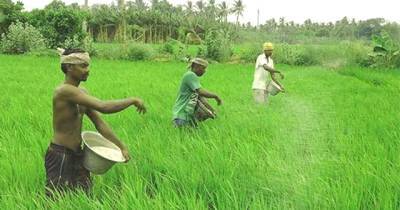MUMBAI, 13 August 2024: India, a land of vibrant diversity, boasts a vast agricultural landscape. From the snow-capped Himalayas to the tropical southern coasts, the country experiences a multitude of climatic conditions.
This climatic heterogeneity demands a strategic approach to crop selection. Here, we delve into some of the top Indian crops that thrive under specific weather conditions, showcasing the remarkable adaptability of Indian agriculture.
Conquering the Cold: Crops for India's Mountain Majesty
1. Apples: The crisp mountain air of Himachal Pradesh, Jammu & Kashmir, and Uttarakhand provides the perfect setting for apple cultivation. These temperate-loving fruits require cool winters and mild summers for optimal growth.
2. Stone Fruits: Plums, peaches, and apricots flourish in the cooler regions of the Himalayas. These stone fruits benefit from the distinct seasonality, with a period of chilling temperatures followed by a warm growing season.
3. Chillies: Believe it or not, some chilli varieties, like the California Wonder chilli, thrive in the colder regions of India. These chillies prefer moderate temperatures and well-drained soils, which are prevalent in the foothills of the Himalayas.
Embracing the Arid Sun: Crops for India's Hot and Dry Lands
4. Cotton: Flourishing in the hot and dry climate of Gujarat, Maharashtra, and Andhra Pradesh, cotton is a mainstay cash crop for Indian farmers. This drought-tolerant plant requires minimal water and thrives under ample sunshine.
5. Millets: Jowar, Bajra, and Ragi are resilient millets that dominate the agricultural landscape of Rajasthan, Haryana, and Karnataka. These drought-resistant grains are perfectly adapted to arid conditions and require minimal irrigation.
6. Pulses: Turmeric dal, Moong dal, and Urad dal are some of the prominent pulses cultivated in the drier regions of India. These legumes are nitrogen-fixing crops, enriching the soil and requiring less water compared to other food crops.
Thriving in the Tropics: Crops for India's Warm and Humid Regions
7. Rice: The lifeblood of India, rice is predominantly cultivated in the fertile plains and coastal regions with abundant rainfall. Varieties like Basmati and Sona Masuri thrive in the hot and humid climate of West Bengal, Punjab, and Andhra Pradesh.
8. Spices: Cardamom, pepper, and cloves are some of the aromatic spices that perfume the tropical regions of Kerala, Karnataka, and Tamil Nadu. These spice crops require warm temperatures, high humidity, and well-distributed rainfall for optimal growth.
9. Sugarcane: Flourishing in the tropical climate of Maharashtra, Karnataka, and Tamil Nadu, sugarcane thrives in hot and humid conditions with adequate irrigation. This water-intensive crop benefits from the abundant rainfall and long growing season in these regions.
10. Plantation Crops: Coffee, tea, and rubber are prominent plantation crops cultivated in the southern states of India. These shade-loving crops require warm temperatures, high humidity, and well-distributed rainfall throughout the year.
Beyond the Obvious: Factors Influencing Crop Selection
While climate plays a crucial role in crop selection, other factors also influence decisions:
Soil Type: The texture, fertility, and drainage characteristics of the soil significantly impact crop suitability. For example, cotton prefers well-drained black soils, while rice thrives in fertile alluvial plains.
Market Demand: Farmers often consider the market demand for specific crops when making planting decisions. The proximity to processing facilities and transportation networks can also influence crop selection.
Government Policies: Government initiatives promoting specific crops or offering subsidies can incentivize farmers to cultivate those varieties.
Cultivating a Sustainable Future: Embracing Crop Diversity
India's diverse climate allows for a rich tapestry of agricultural crops. By strategically selecting crops based on weather conditions and other factors, farmers can optimize yields, ensure food security, and promote sustainable agricultural practices. Embracing crop diversity also helps mitigate risks associated with unpredictable weather patterns and promotes long-term agricultural resilience.
Leveraging Technology for Informed Decisions
Advancements in technology offer valuable tools for informed crop selection. Weather forecasting data, climate-smart agriculture apps, and soil analysis techniques can empower farmers to make data-driven decisions that optimize agricultural productivity and profitability.
A Nation United by Diverse Crops
India's weather-centric crop selection highlights the remarkable adaptability of its agricultural sector. By harnessing the strengths of various crops suited to specific climatic conditions, Indian agriculture thrives and caters to the nation's diverse food needs. As the nation strives for a sustainable future, embracing crop diversity, utilizing technology, and promoting climate-smart practices will be crucial for ensuring the long-term success of Indian agriculture.
Image credit: blog.sathguru.com























